Tillage and crop management impacts on soil loss and crop yields in northwestern Ethiopia
2022-09-26FkrmariamAsargwMirtiAtsusiTsunkawaNigussiHargwynEnywAgoMitsuruTsuboKiniyEbabuTsugiyukiMasunagaBiranuKbDrgTsgayMssaWataruTsujiMuluknBayablMulatuLiywBriun
Fkrmariam Asargw Mirti ,Atsusi Tsunkawa ,Nigussi Hargwyn ,Enyw Ago ,Mitsuru Tsubo ,Kiniy Ebabu ,,Tsugiyuki Masunaga ,Biranu Kb ,Drg Tsgay Mssa ,Wataru Tsuji ,Mulukn Bayabl ,Mulatu Liyw Briun
a The United Graduate School of Agricultural Sciences,Tottori University,4-101 Koyama-Minami,Tottori,680-8553,Japan
b Amhara Regional Agricultural Research Institute,P.O.Box,527,Bahir Dar,Ethiopia
c Arid Land Research Center,Tottori University,1390 Hamasaka,Tottori,680-0001,Japan
d International Platform for Dryland Research and Education,Tottori University,1390 Hamasaka,Tottori,680-0001,Japan
e College of Agriculture and Environmental Sciences,Bahir Dar University,P.O.Box 1289,Bahir Dar,Ethiopia
f Faculty of Life and Environmental Science,Shimane University,Shimane,Japan
g Faculty of Civil and Water Resource Engineering,Bahir Dar Institute of Technology,Bahir Dar University,P.O.Box,252,Bahir Dar,Ethiopia
h Faculty of Agriculture,Tottori University,Tottori,Japan
Keywords:Drought-resistance Grain yield Reduced tillage Row planting Soil erosion Teff
A B S T R A C T Lack of appropriate agronomic practices is one of the major causes for soil erosion and low yields in teff(Eragrostis tef[Zucc.])production in Ethiopia.A 3-yr study was conducted at the Aba Gerima watershed in northwestern Ethiopia,to investigate the effects of two tillage practices(reduced tillage[RT]and conventional tillage[CT]),two planting methods(row planting[RP]and broadcast planting[BP]),and two compaction options(with[+T]and without[—T]trampling)on soil loss and teff yields in a split-split plot arrangement.Sediment concentration ranged from 0.01 to 5.37 g L-1(mean,0.25 g L-1)in our study.Accordingly,the estimated total(August—October)soil loss ranged from 0.2 to 0.5 t ha—1(mean,0.3 t ha—1).The sediment concentration and total soil loss were significantly influenced(P<0.05)by tillage,planting methods,and trampling only in the third monitoring year.RT reduced soil loss by 19%relative to that of CT,whereas RP resulted in a 13% reduction in soil loss over BP.The-T plots showed a 15%reduction in soil loss as compared to+T plots.Results revealed significant increase in soil total carbon and nitrogen in RT and—T.Less soil loss and greater teff grain yield were obtained in plots with improved agronomic practices(RT and RP)compared to conventional ones(CT and BP).Based on our findings we conclude that the use of RT,RP,and—T practices can effectively minimize soil loss without any crop yield penalty.
1.Introduction
Soil erosion is a major environmental problem worldwide,and it is of a particular relevance to the agricultural sector in Ethiopia(Haregeweyn et al.,2015;Hurni,1983,pp.131—142).The annual soil loss due to erosion by water from Ethiopian highlands ranges from 20 to 80 t ha—1yr—1(Adimassu et al.,2014;Berihun et al.,2020;Haregeweyn et al.,2017;Hurni,1983,pp.131—142),and the average soil loss rate from cultivated lands was estimated as 42 t ha—1yr—1(Hurni(1993).Soil loss from cultivated lands in the Upper Blue Nile basin is mostly driven by inappropriate land management practices(Ebabu et al.,2019),including excessive tillage,continuous cropping,and low organic matter addition(Oicha et al.,2010b).Proper management of croplands will thus play a huge role in reversing the problem caused by soil erosion and maximizing crop production in low-input,rain-fed agriculture.
The area under cultivation accounts for 15% of the total land in Ethiopia(Taffesse et al.,2012).The major cereal crops grown are teff(Eragrostis tef[Zucc.]),wheat(Triticum aestivumL.),barley(Hordeum vulgareL.),sorghum(Sorghum bicolor[L.]Moench),and maize(Zea maysL.).Among these,teff takes the major share of total crop production,with 3 million ha of land cultivated in teff(CSA,2018).Teff supports millions of people as a staple food crop in Ethiopia.Teff is grown mainly as a forage crop outside Ethiopia,but demand for the grain is expanding worldwide owing to its nutritional benefits,mainly as it is gluten free and is rich in lysine,iron,and calcium(Assefa et al.,2011).However,its production system is highly challenged by decline in soil fertility exacerbated by poor agronomic practices(Habta Werede et al.,2018).In the conventional teff cultivation system,the land undergoes more than four tillage operations,using oxen as the main source of draft power,followed by soil compaction(trampling)using a large number of cattle and donkeys immediately before broadcast sowing,with teff seeds randomly scattered over the compacted ground.The intended purposes of frequent plowing in the conventional teff cultivation are to create a fine seed bed for better crop establishment,reduce weed infestation,and enhance rainwater infiltration and soil aeration(Lipiec et al.,2006).However,repeated tillage may aggravate soil erosion by depleting soil organic matter and reducing plant cover(Zhang et al.,2019).Reduced tillage systems could reverse problems posed by traditional tillage practices(Temesgen et al.,2009).Impacts of tillage methods on soil erosion are highly dependent on crop type;plot scale;tillage implement;time,frequency,and duration of tillage;soil type;and climatic variables(Temesgen et al.,2008).
Overall,agronomic practices of the conventional teff cultivation system are the major reasons for low productivity and soil resource degradation(Vandercasteelen et al.,2013).Because teff covers the majority of cultivated lands in Ethiopia,implementation of good agricultural practices that can improve teff productivity without harming soil resources would be crucial for the sustainable use and management of cultivated lands in erosion-sensitive areas and elsewhere.Therefore,the government of Ethiopia has been promoting reduced tillage and row-planting practices without soil trampling as the most promising agronomic options to reduce soil erosion from teff fields and improve crop yield.However,no or little information is available about the effectiveness of these practices under the crop husbandry and production contexts of teff.Given all these facts,this study was initiated following the hypothesis that reduced tillage practices and row planting without trampling would be sustainable management options that can improve crop productivity by conserving soil resources.Therefore,this study investigated the impacts of different tillage,planting,and trampling practices on(1)sediment concentration and soil loss during the teff growing period(August—October),and(2)teff grain and straw yields.
2.Materials and methods
2.1.Site description
The study was conducted at the Aba Gerima watershed in the Upper Blue Nile basin of northwestern Ethiopia(Fig.1).According to long-term climate data from the meteorological station near the experimental site(Fig.2),the study area is characterized by a unimodal rainfall pattern with annual rainfall ranging from 895 to 2037 mm,most of which occurs from June to September;the minimum and maximum temperatures are 13 and 27°C,respectively.Nitosols and Leptosols are the dominant soil types in the watershed based on the FAO soil classification system(Mekonen,2016).Top soil(0—20 cm)of the study site has an average organic carbon content of 11 g kg-1,total nitrogen of 1.1 g kg-1,available phosphorus(Olson)of 16.5 mg kg-1,pH of 5.6,and exchangeable K of 1.1 cmol kg-1and the texture is classified as clay(35%sand,26%clay,and 39% silt).
A mixed crop—livestock farming system is the main practice.Maize,teff,finger millet(Eleucine coracanaGaertn.),wheat,barley,khat(Catha edulis[Vahl]Forssk.ex Endl.),and hot pepper(Capsicum frutescensL.)are among the major cash crops produced in the watershed(Teshager Abeje et al.,2019).
2.2.Treatments and experimental setup
Two tillage practices,two planting methods,and two trampling practices(2×2×2=8 treatment combinations)were evaluated.The tillage practices were reduced tillage(RT),with one plowing at the time of teff planting,and conventional tillage(CT),with four plowings(once in April,twice in June,and once in July).The two planting methods were row planting(RP),with 25-cm row spacing and 10 kg of seed ha—1,and broadcast planting(BP),with 25 kg of seed ha—1.The two trampling practices were trampling immediately before planting(+T)and sowing without trampling(—T).Treatments were assigned to each experimental unit following a split-split-plot arrangement.Tillage practices were assigned as the main plot factor,planting methods were assigned as a subplot factor,and trampling practices were assigned as a sub-subplot factor.Therefore,there were eight sub-subplots,and the size of each was 30 m×3 m(90 m2).Plots were runoff plots separated by iron sheets of 40-cm depth of which 20 cm was inserted below the ground.The plots were laid out on uniform land with a 12% slope gradient.Runoff and soil coming from each plot were collected by a trench measuring 3 m in length,1 m in depth,2.5 m in width at the top and 1.25 m at the bottom.The trenches were placed at the bottom of the runoff plot and lined with plastic geo-membrane.The volume of each trench was nearly 4.1 m3,determined by considering the highest rainfall and runoff coefficient of the area(Hudson,1993).Graded soil bunds were constructed uniformly across the experimental site as a common soil and water conservation practice in the study area(Adimassu et al.,2014,2018).The bund has a bottom width of 1.2 m,height of 0.5 m;and 1:2 side slope as prescribed by the MoA(2001).As a result,each runoff plot was divided into four compartments(blocks/replications)separated by soil bunds.

Fig.1.Map of the study area(Aba Gerima watershed)located in the Upper Blue Nile basin,Ethiopia.
In each cropping season,teff planting was performed in late July and harvesting was done in late November(for details,see Table 1).The popular locally adapted teff variety‘Quncho’was used.Nitrogen and phosphorous were applied to all plots at rates of 64 kg N ha—1and 46 kg P2O5ha—1,in the form of urea[(NH2)2CO]and diammonium-phosphate fertilizers,respectively.All P2O5and half of the N was first applied and mixed with the soil before sowing teff seeds;the remaining N was applied at 30 days after sowing.Tillage and trampling activities were done manually by using human labor(It was not practical to use oxen for our tillage treatments and cattle for trampling due to the difficulties in managing them in such experimental plots).Tillage was done at the depth of~25 cm using a hand-hoe.Trampling was conducted by walking over the plots.Farmers in the study area use human labor or oxen for tillage and trampling operations depending on the availability of resources(Temesgen et al.,2009).

Table 1Summary of treatments and agronomic practices applied during the three monitoring seasons(2017̶2019).
2.3.Data collection and analysis
The runoff and sediment concentration from each plotwere monitored during the main rainy season within the teff growing period(August—October).Runoff and sediment concentration samples were measured daily at each plot every morning at 8:00 a.m.local time.Daily rainfall was also recorded using an automatic rain gauge installed near the experimental plots.The volume of runoff collected in each trench was measured using a plastic bucket of known volume.The actual daily runoff volume for each plot was calculated by subtracting the estimate of rainfall directly received on the surface area of the trench(Ebabu et al.,2019).Total actual daily runoff volume was then converted to depth(mm)by dividing it by the plot area.After sufficient stirring,runoff samples of 1 L were taken using a plastic bottle(Ebabu et al.,2019;Hudson,1993).Sediment concentration(g L—1)was determined by filtering each sample using Whatman 42 no.1 paper filter with a pore size of 1.2 μm,and oven drying it at 105°C for 24 h.Total amount of eroded soil(soil loss)from each plot was then calculated by multiplying the sediment concentration and the actual runoff volume.Soil moisture was monitored daily by using a moisture sensor(Decagon EC-5,METER Group,Inc.USA)and data logger(EM 50)installed in each plot at a depth of 20 cm.
Five samples were collected and a composite soil sample was prepared from each plot at a depth of 0—20 cm before(in 2017)and after the 3-yr experiment(in 2019).The soil samples were analyzed for total nitrogen(TN),total organic carbon(TOC),available P,pH,and electrical conductivity(EC).TN was analyzed using the Kjeldahl method(Bremmer&Mulvaney,1996),and TOC was determined as described by Nelson and Sommers(1996).Available P was determined using the Olsen extraction method(Olsen et al.,1954).pH and EC were determined based on the potentiometer principle(Peech,1965);pH was determined in 1:25 soil:water solution using a pH meter and EC was measured with a conductivity meter.For each plot,soil core sampling was done pre-sowing and postplanting using a core sampler of volume 100 cm3(5-cm depth×2.5 radius).The soil core samples were oven-dried at 105°C for 24 h.Bulk density was then calculated as a ratio of ovendried soil to volume of the core sampler.
In great haste the old man sprang from his bed, and covered the flower with the cloth the old witch had given him, and in a moment the beautiful Princess Hyacinthia stood before him
Every 15 days,teff biomass yield was sampled randomly at two sampling points in each compartment(replicate)within each runoff plot(8 samples per plot)using a 0.25-m2quadrat.The teff biomass sampling was started after 20 days after sowing.The collected teff biomass samples were oven-dried at 80°C for 24 h to determine the aboveground teff biomass over the growing period.At physiological maturity,grain yield and straw yield were quantified using 1-m2quadrats(8 samples per plot);teff samples were sun-dried for 4 days,manually threshed,and grains were separated from husks;weight of grains and straw was quantified using a LABMAN analytical balance.

Fig.2.Long-term(2000—2019)monthly rainfall and temperature within the Aba Gerima watershed.
Data were analyzed using R statistical software version 3.3.2(Team,2013).Before analysis,data were checked for a normal distribution by using the Shapiro—Wilk procedure(Shapiro&Wilk,1965).Analysis of variance was performed,and means were separated using the least significant difference procedure(Williams &Abdi,2010)to detect treatment differences.Correlation among parameters was determined following Pearson’s method as illustrated by Gomez and Gomez(1984).Regression analysis was performed to define mathematical relationships among parameters.
3.Results
3.1.Sediment concentration and soil loss
Averaged over treatments and years,sediment concentration ranged from 0.01 to 5.37 g L—1.The daily mean soil loss ranged from 0.0002 to 0.08 t ha—1,with a mean of 0.02 t ha—1.The total soil loss(August—October)ranged from 0.2 to 0.5 t ha—1,with a mean of 0.3 t ha—1.When assessing the individual effects,sediment concentration and soil loss were significantly influenced(P<0.05)by tillage(CT>RT by 19%)and trampling practices(+T>—T by 15%)in 2019,but the effect was not significant in 2017 and 2018(Table 2).Planting method had no significant impact on sediment concentration in any year,but it significantly(P<0.05)affected soil loss in2017(RP<BP by 19%)and 2019(RP<BP by 7%)(Table 2,Fig.3b).Except for the three-way interaction(tillage×planting method×trampling)effect on sediment concentration in 2019(the highest was at CT/BP/+T),no other interactions(tillage×planting method,tillage×trampling,planting method×trampling)significantly affected sediment concentration and soil loss in our study(Table 2).In general,the impact of the three practices on sediment concentration and soil loss became more significant in the third year(2019)than in the first and second years of the experiment.The box-and-whisker plots(Fig.4)indicated that there was substantial variability in sediment concentration among different combinations of tillage,planting method,and trampling practices.The combination CT/BP/+T(farmer’s practice)resulted in the highest sediment concentration followed by CT/RP/-T and CT/RP/+T,whereas RT/BP/+T gave the lowest sediment concentration followed by RT/RP/-T and RT/BP/-T.Overall,based on the soil loss results,our findings reveal that the teff cultivation system that involves several tillage operations,broadcast planting,and trampling is not efficient compared to improved practices(reducing tillage,row planting,and avoiding trampling).
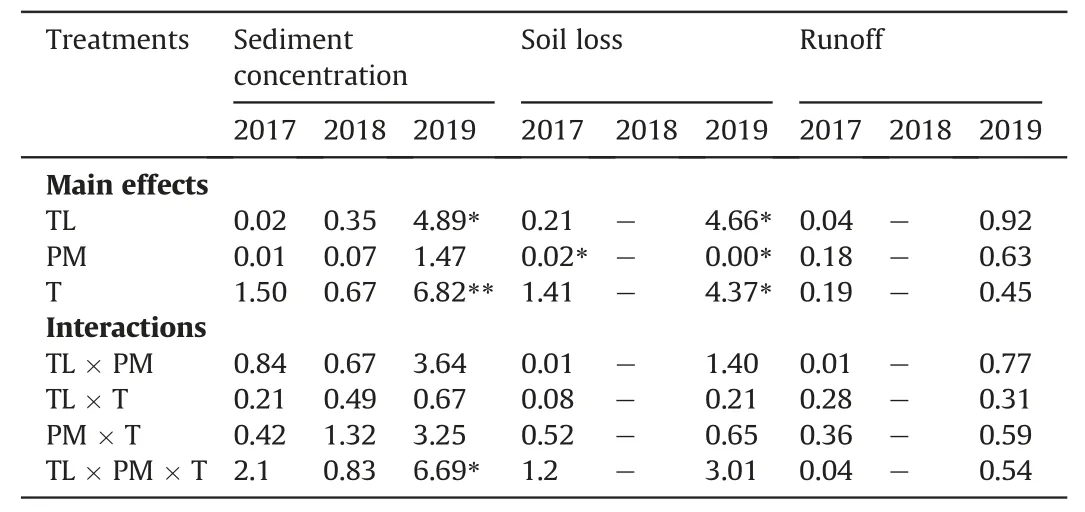
Table 2Summary of results of analysis of variance(F-values)for the main and interaction effects of tillage(TL),planting method(PM),and trampling practice(T)on sediment concentration,soil loss,and runoff in 2017,2018,and 2019 cropping seasons.
3.2.Temporal trends in sediment concentration and soil loss
The average sediment concentrations in 2017,2018,and 2019 were 0.29±0.37,0.16±0.31,and 0.27±0.45 g L—1(mean±SD),respectively(Fig.3).Similarly,total soil loss in 2017(0.37 t ha—1)was greater than that in 2019(0.25 t ha—1;Table 3).Seasons with more rainfall generated higher runoff that caused greater soil loss,as clearly demonstrated by the positive correlation between runoff and soil loss(Fig.5).The monthly trend showed that sediment concentration and soil loss were relatively higher in August and September,and lowest in October in all the study years(Fig.6).In August and September,the rainfall was higher(relative to October)(Table 4 and Fig.2)and teff biomass cover was lower(Fig.7)However,some extreme rainfall events coupled with soil disturbance associated with weeding also generated high sediment concentration and soil loss in September.
3.3.Soil properties and moisture
During the end of the experimentation(2019),tillage(RT>CT)had a significant(P<0.05)effect on total nitrogen(TN)and total organic carbon(TOC),but not bulk density pH,available P and exchangeable K(Table 5).Planting method and trampling did not significantly(P>0.05)influence soil properties(Table 5).Trampling had a significant impact on TN(—T>+T),TOC(—T>+T)and bulk density(—T<+T).Trends in Fig.8 showed that the moisture content of consistently higher in RT than in CT throughout the growing seasons(Aug—Oct).Soil moisture was higher in RT than CT;and in+T than—T during September and October.
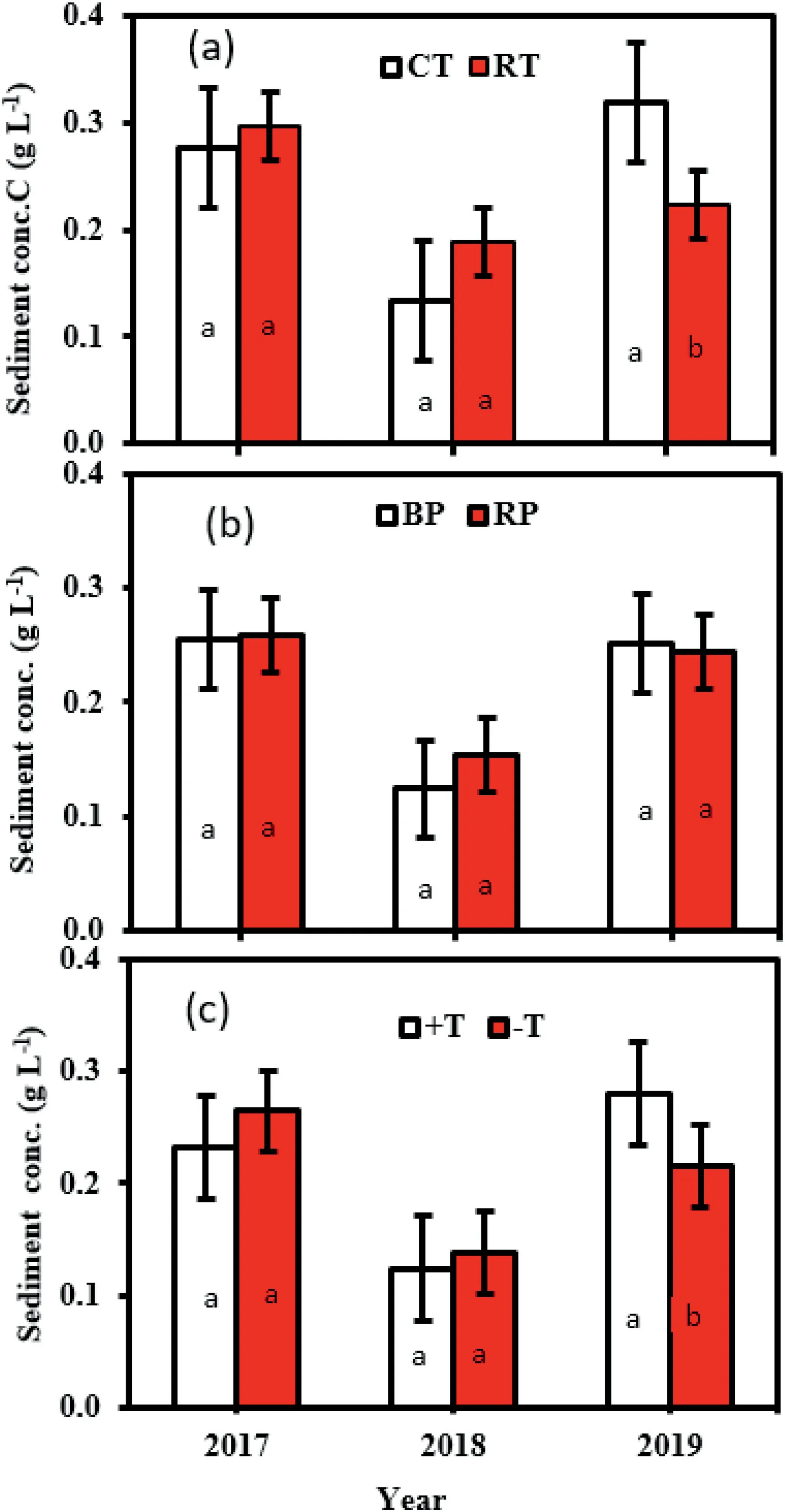
Fig.3.The individual effects of tillage(a),planting method(b),and trampling(c)on sediment concentration(SC)during the three monitoring seasons.Numbers of observations(n)were 24,19,and 22 for 2017,2018,and 2019,respectively.In each season,means with the same letter are not significantly different.CT,conventional tillage;RT,reduced tillage;BP,broadcast planting;RP,row planting;+T,with trampling;-T,no trampling.The error bars indicated are standard deviations.
3.4.Crop yield
Combined over years,tillage(RT>CT)had a significant(P<0.05)impact on teff grain yield,whereas planting method and trampling did not(P>0.05;Table 6).
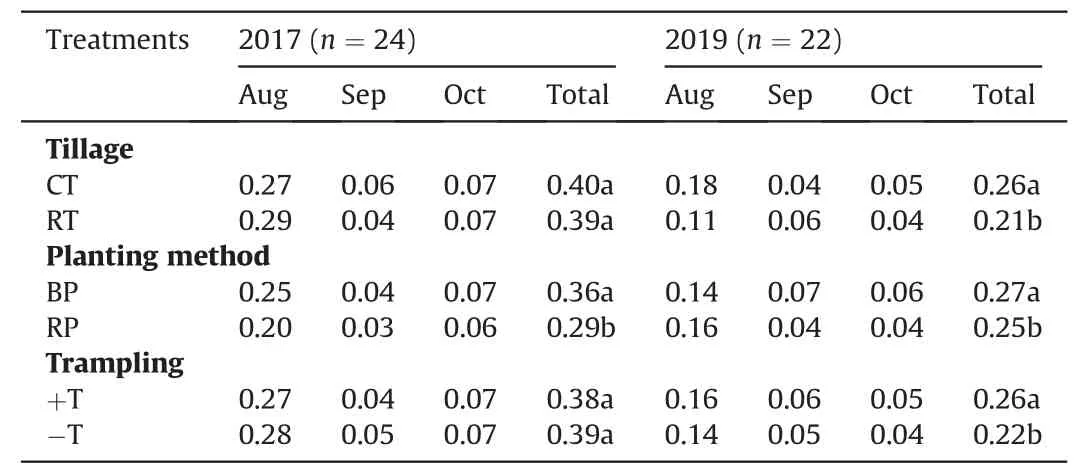
Table 3The effects of tillage,planting method,and trampling practices on monthly and total soil loss(t ha—1)in 2017 and 2019 teff growing seasons.

Table 4Monthly rainfall amount and minimum,maximum,and mean rainfall intensity observed during the three cropping seasons(2017—2019)using data collected from automatic rain gauges on site.

Fig.4.The combined effects of tillage,planting methods,and trampling on sediment concentration in 2019(n=22).The top and bottom of each box represent the upper and lower quartiles,respectively;the horizontal line and×within each box represent the median and mean,respectively;whiskers represent variability outside the upper and lower quartiles.CT,conventional tillage;RT,reduced tillage;BP,broadcast planting;RP,row planting;+T,with trampling;-T,no trampling.
Teff straw yield,however,was significantly(P<0.05)influenced by tillage(RT>CT),planting method(RP>BP),and trampling(+T>—T).None of the interaction effects was found to be significant on grain yield and straw yield(P>0.05).
4.Discussion
4.1.Sediment concentration and soil loss
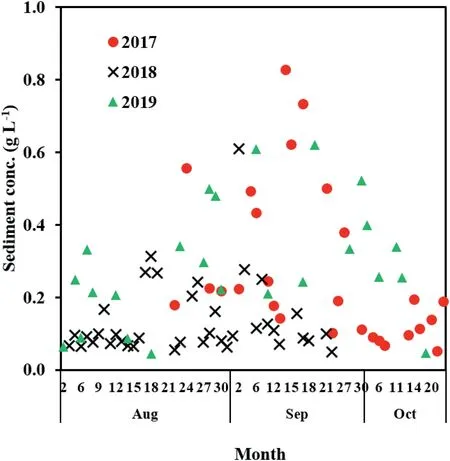
Fig.6.The trends of daily sediment concentration(SC)across months in 2017,2018,and 2019.The total number of observations(averaged over treatments)were n=24 events for 2017,n=18 events for 2018,and n=22 events for 2019.
In line with our study,Ebabu et al.(2019)reported that sediment concentration in crop land ranged from 0.04 to 5.13 g L—1in the Aba Gerima watershed.However,generally,the soil loss observed in our study was lower than that reported in Ethopian croplands in previous studies.Accoring to Hurni(1993),soil loss from cultivated lands in Ethiopia might be as much as 42 t ha—1depending on the agro-ecological conditions.Other studies also noted that soil loss from agricultural lands is highly variable and dependent on rainfall,slope,soil type,land use,and plot size(Adimassu et al.,2014;Stroosnijder,2005).The soil loss rates in the current study are far lower than those reported by Ebabu et al.(2019)for croplands in the Upper Blue Nile basin(0.01—5.00 t ha—1).This discrepancy mainly reflects the fact that the monitoring period in this study was limited to the teff growing period(August—October),whereas much of the soil loss in the region may occur in June and July,when rainfall is higher and the land is bare and/or with limited crop cover(Brenner et al.,2013,p.5392).Furthermore,the lower soil loss rates could be attribited to the sediment trapping efficiency of the graded soil bunds uniformly constructed in our experimental plots;soil bunds have been reported to reduce soil loss by 40%—50% in Ethiopia(Herweg & Ludi,1999)and by 60%—86% in the Upper Blue Nile basin(Ebabu et al.,2019).
The lower sediment concentration and soil loss in RT was likely due to the favorable conditions for rainwater infiltration owing to minimal soil disturbance(minimal tillage);the less the disturbance,the lower the soil detachment and transportation by the rain and surface runoff(Wang et al.,2019).The higher sediment concentration and soil loss in CT might be attributed to tillage-induced soil disturbances(Kurothe et al.,2014).Several studies reported that RT effectively reduced soil loss.For instance,Adimassu et al.(2019);Kurothe et al.(2014)showed that minimum tillage with a sufficient amount of crop residue reduced soil erosion compared to CT systems.Minimum tillage also aids the gradual build-up of soil organic matter and protects the topsoil(nutrients)from being washed away by surface runoff.At 3 yr after the implementation of RT,our results also demonstrated improvements in soil TOC and TN(Table 5).Under minimum tillage systems,accumulation of soil organic matter facilitates the formation of soil aggregates,increases soil porosity,and improves soil infiltration capacity,which can help improve crop yield and reduce runoff and sediment loss(Zuazo &Pleguezuelo,2009).The mechanism by which the RT system reduces soil erosion also improves soil properties(Myers & Wagger,1996),modifies microtopography,and improves soil protection(Lal,1995,pp.52—58).As a result,traditional tillage practices with greater plow frequency and complete crop residue removal are among the major drivers of land degradation in Ethiopia(Tebebu et al.,2017).

Table 5Effects of tillage,planting method,and trampling treatments on total nitrogen(TN),total organic carbon(TOC),and bulk density of soil samples collected in 2017(baseline,before experiment)and after the 3-yr experiment(2019).
The greater soil moisture concentrations under RT are also likely to have contributed to the higher grain and biomass yield observed under RT treatments.Minimum tillage increases crop biomass and yields by providing more available moisture,which can support better crop growth performance(Rockstr¨om et al.,2009).As a result,the teff biomass was consistently higher in RT than in CT plots(Fig.7).Better teff biomass(vegetation cover)in RT plots likely to have enhanced soil protection against erosion by rainwater and explained the lower soil loss compared to that of CT.Sufficient vegetation cover is an integral part of successful soil erosion management(Rockstr¨om et al.,2009).RT practices will effectively reduce erosion only if coupled with sufficient crop residue and vegetation cover(Cooper et al.,2017;Minella et al.,2018).

Fig.7.The pattern of teff biomass yield(BY)during the measuring season of 2019,as influenced by tillage(a),planting method(b),and trampling(c).CT,conventional tillage;RT,reduced tillage;BP,broadcast planting;RP,row planting.Points with Means with the same letter are not significantly different at P=0.05).
The RP method often leads to the production of greater biomass due to efficient utilization of soil resources(moisture,nutrients,and light).In BP,however,the seeds are randomly scattered at high plant density and weed competition is also higher.Our results indicate that the increased biomass production under RP practices(Table 6)is likely to be responsible for the reduction in soil loss also observed in RP treatments(Table 3),and the effect is highly dependent on crop type,growing stage,and management factors(Shelton et al.,1986).In addition,the effectiveness of RP over BP in reducing soil loss might be due to the improved root development such as a better root length and formation of crown roots in cereal crops(Zuazo&Pleguezuelo,2009)that create good anchorage and protect the soil from detachment and transportation.
Avoiding trampling(-T)reduced soil loss by 15% compared to trampling(+T),mainly due to the low bulk density(Table 5)owing to the absence of surface compaction and sealing.Despite it was not significant,the higher compaction of+T probably decreased infiltration and aggravated runoff and soil loss,particularly in the beginning of the growing season(August),when the soil was disturbed by tillage and planting and rainfall was higher.Concurrent to our study,Amare et al.(2006)also reported that cattle trampling in teff increased runoff and soil loss.Soil compaction(trampling)due to farm activities can alter the soil structure,in turn hindering soil infiltration and aggravating soil erosion(Muche et al.,2014).Other studies also illustrated that cattle trampling damages soil structure,hinders water infiltration,and aggravates soil loss from grazing lands with high livestock pressure for a longer period of time(Chai et al.,2019;Wu et al.,2020).However,the impact of trampling is governed by the purpose,level of compaction,trampling technique,and soil type(Savabi&Giffor,1987).Few studies have addressed the impacts of trampling on soil loss in crop fields,but this is particularly important for teff,as it is the only crop that involves trampling during planting.Our findings indicated that trampling aggravates soil loss from teff fields despite its potential benefits in favoring better teff seed establishment,good root anchorage,and preventing soil from drying quickly(Fufa et al.,2000).
Overall,our results support those of other authors who have found that the traditional crop cultivation system aggravates soil loss from agricultural lands in Ethiopia(Berihun et al.,2019;Mariye et al.,2020).The significant interaction(tillage×planting method×trampling)effect on sediment concentration observed in our study also highlights the fact that conservation practices often have a greater impact when used in combination in relatively high rainfall seasons(Minella et al.,2018).Kidane and Alemu(2015)suggested that minimum tillage and improved agronomic technologies might reduce the risk of soil loss from teff-cultivated fields.Given that trampling is a unique practice in teff cultivation,reduced tillage practices were also proven effective in reducing soil erosion and improving soil quality(Ebabu et al.,2019).Furthermore,studies on teff(Oicha et al.,2010a),wheat(de C′arcer et al.,2019),and maize(Busari et al.,2015)reported that minimum tillage operations improved crop yield without affecting soil quality.
4.2.Temporal trends in sediment concentration and soil loss
The differences in sediment concentration and soil loss among years were attributed to variations in rainfall amount and intensity(Table 4),which were higher in 2017 than in 2018 and 2019,particularly in August when vegetation cover was low.However,soil loss was much greater in 2017 than in 2019,mainly due to the major soil disturbance that occurred during experimental plot establishment.Likewise,in our study the significant responses to treatments were more pronounced in 2019 than in 2018 and 2017 due to the carry-over effects and the relative stability of experimental plots later in the study period.Studies in similar areas of Ethiopia reported that sediment concentration is higher during the start of the rainy season(July and August),when soil is washed away by torrential rains and exacerbated by less ground cover(Ebabu et al.,2019;Gashaw et al.,2018).The higher the rainfall amount and intensity,the greater the detachment and transportation of soil particles(Chen et al.,2018;Renard,1997).Greater biomass cover plays an important role in reducing the rainfall energy and gives more time for rainwater to infiltrate without detaching and transporting soil particles(Kort et al.,1998).
4.3.Crop yield
Over the period of this study,greater crop yield was observed in RT plots.The difference was attributed to better growing conditions observed in RT plots,where both the soil moisture(Fig.8)and soil N were higher(Table 5),which brought about enhanced teff growth(biomass gain)compared to CT(Fig.7).likely due to reduced organic matter decomposition as a result of reduced soil disturbance,and due to reduced organic matter loss via erosion.In addition,the less soil loss in RT might have prevented the applied fertilizer(urea and diammonium phosphate)from being washed away by runoff(Smith et al.,2007).Therefore,our findings corroborated reports that RT can serve as one of the best agronomic practices for conserving soil nutrients and improving both grain yield and straw yield of teff.Bahrani et al.(2007)and Berner et al.(2008)also reported that RT increased crop yield.Although it should be noted that the impact of RT systems on crop yield,is highly variable and depends on factors such as crop species(Joshi et al.,2007),soil type(Carter,1992),climate(Van Kessel et al.,2013),tillage implements(Larney & Bullock,1994),amount of crop residue(Bescansa et al.,2006),plot scale(Raclot et al.,2009),and number of years of implementation.
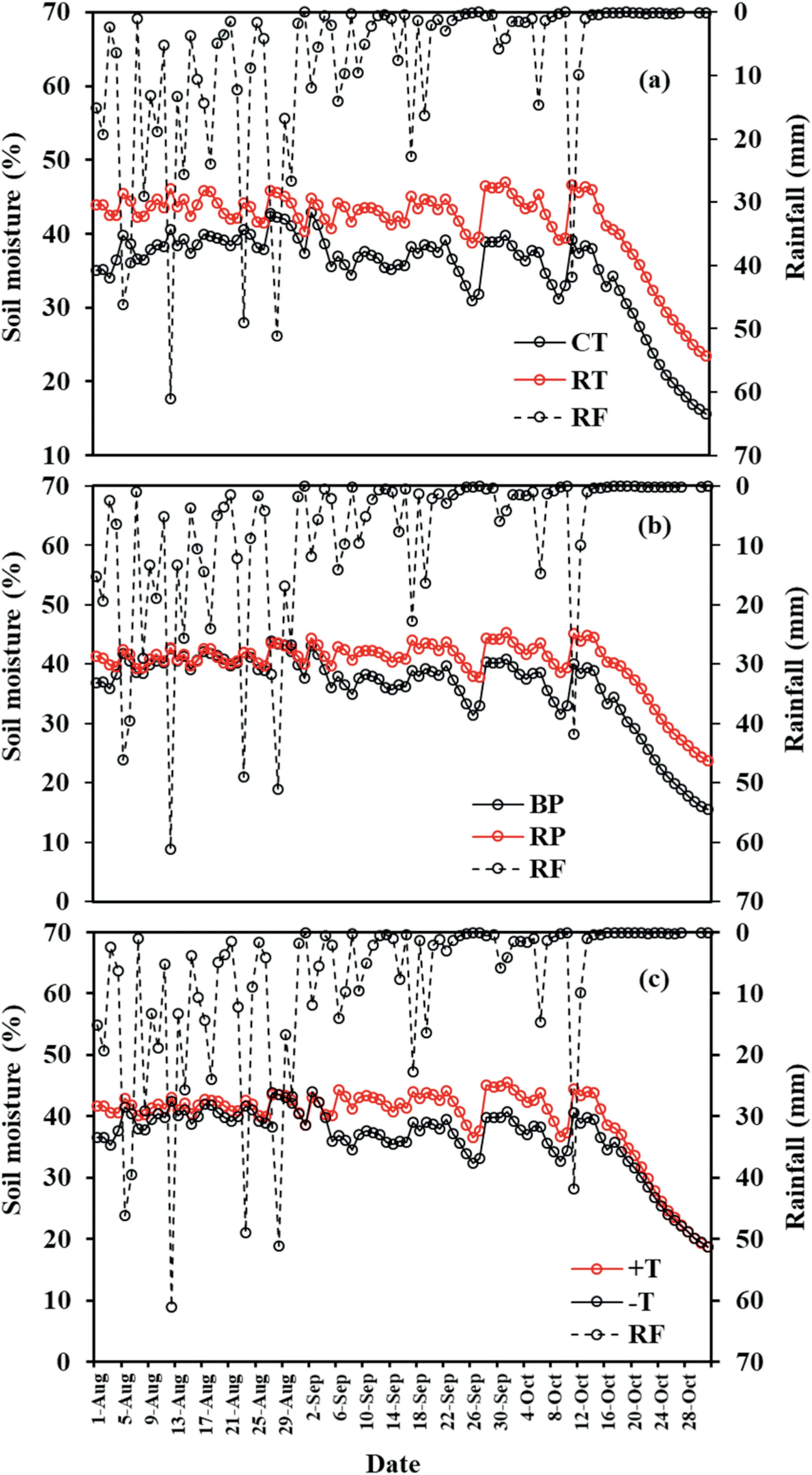
Fig.8.The effects of tillage(a)and planting methods(b)on daily soil moisture content during the measuring period in 2019.CT,conventional tillage;RT,reduced tillage;BP,broadcast planting;RP,row planting;RF,rainfall.
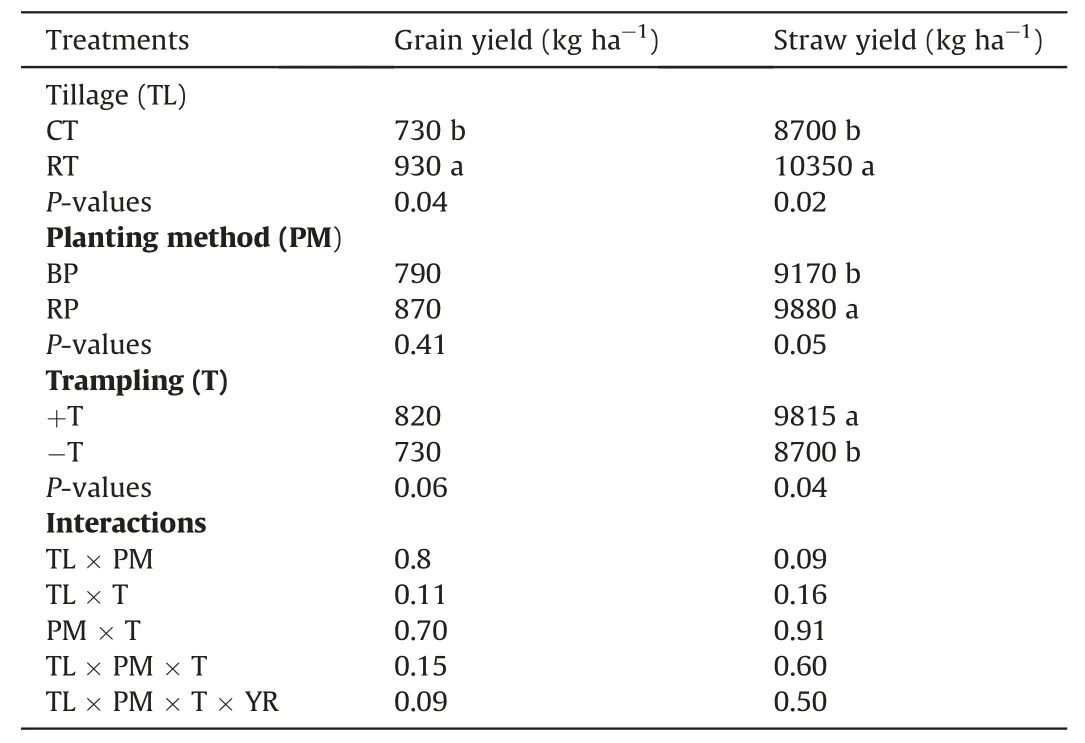
Table 6Effects of tillage,planting methods,and trampling on teff grain and straw yield at harvest,combined over years.
The improved teff growth conditions in RP were mainly due to the better soil moisture(Fig.8b)and high tillering capacity.Our results thus indicated that RP was an efficient agronomic practice to increase straw yields with reasonable reduction in soil loss.Berhe et al.(2011)and Mihretie et al.(2021)also suggested that RP can improve crop establishment during drought,tillering capacity,seed distribution,root development,and lodging resistance.The better straw yield from+T was probably due to better soil moisture(Fig.8b),good crop establishment(root anchorage),reduced weed pressure,and lodging,which implied enhanced teff growth(Table 6 and Fig.7).Given there was no significant impact on grain yield,the high soil loss in the+T treatment highlights the importance of avoiding trampling in the teff production system.Moreover,trampling is a labor-intensive activity that incurs extra costs to teff growers.Even though there was little evidence explaining the impact of trampling on crop yield,in a previous study,the positive impact of trampling on teff yield was associated with its role in good crop establishment and moisture conservation(Hailu&Seyfu,2000).Our study also showed that+T plots slightly maintained better soil moisture compared to—T though not statistically significant(P>0.05).Trampling in teff prevents the soil surface from drying quickly in the early growth stages(Fufa et al.,2000).Despite the immediate benefits observed in improving teff biomass,the high soil loss in+T might lead to soil degradation,decline in soil fertility and reduction in crop productivity in the long-term.
5.Conclusions
Based on our findings,we conclude that reduced tillage practices integrated with improved and maintained planting systems(row planting without trampling)effectively reduced soil losses and improved teff productivity.Greater grain yield under RT and straw yield under RT and RP,and reduction in soil loss was strongly associated with the better topsoil conditions and teff biomass cover.Temporal soil loss patterns in our study were attributed to trends in rainfall amount,rainfall intensity,and teff biomass cover.Better soil organic matter and moisture retention in reduced tillage and row planting led to greater growth and yields of teff.However,the benefits from reduced tillage practices can be maximized if properly integrated with crop residue management and mixedcropping systems(intercropping and crop rotation).Thus,future research is crucial to investigate the long-term impact of agronomic practices including the effects of crop residue management and different cropping systems on soil erosion,changes in soil properties,and crop productivity.
Acknowledgments
This research was supported by the Science and Technology Research Partnership for Sustainable Development(grant no.JPMJSA 1601),Japan Science and Technology Agency,and Japan International Cooperation Agency.
杂志排行
International Soil and Water Conservation Research的其它文章
- GUIDE FOR AUTHORS
- A detailed reconstruction of changes in the factors and parameters of soil erosion over the past 250 years in the forest zone of European Russia(Moscow region)
- Changes in hydrologic components from a mid-sized plots induced by rill erosion due to cyanobacterization
- Organic manure input and straw cover improved the community structure of nitrogen cycle function microorganism driven by water erosion
- Soil properties characterization for land-use planning and soil management in watersheds under family farming
- Land surface roughness impacted by typical vegetation restoration projects on aeolian sandy lands in the Yarlung Zangbo River valley,southern Tibetan plateau
